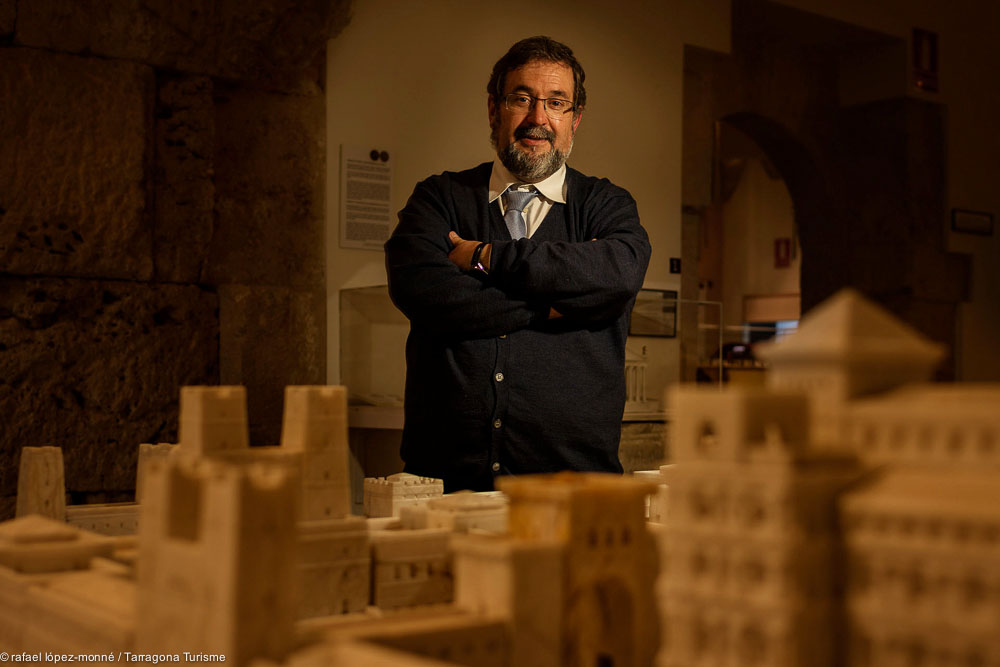
January 259 AD. Fructuosus, Bishop of Tarraco, and deacons Augurius and Eulogius are burned alive on a stake in the Amphitheatre. Roman Emperor, Valerian, has promulgated laws that allow for Christians to be persecuted, and the execution of their spiritual leaders is a true catastrophe for the community existing in Tarragona. However, the martyrdom of Fructuosus and other Christian significances of the same period will make this religion, which will soon officially embrace the whole Empire, rapidly spread. On top of the very same ground Fructuosus earned his Saint name would stand, in the 6th century, a martyrdom basilica that would gather pilgrims from all over Europe.
Tarragona, the city that, according to tradition, turned Saul of Tarsus into Paul the Apostle in the 1st century AD, was led to crisis little after the martyrdom of Fructuosus. Franks, a barbarian tribe, used the misrule of Rome to loot Tarraco just one year after. So much misfortune didn’t seem to weaken the faith of local Christians though. On the contrary; the importance of a number of archaeological findings, such as the extensive area of burials and early-Christian basilicas found nearby the river Francolí –added to the existence of historic news that highlight the key role of the Bishop of Tarraco against the rest of prelates of the Peninsula– leads us into thinking that “Tarragona was once the early Christian’s landmark in Hispania”, according to the archaeologist and biblical scholar Andreu Muñoz, president of the Associació Cultural Sant Fructuós.
Records of the martyrdom of Saint Fructuosus, which tell us everything from the moment the clerks were arrested until the moment of their glorification, became very popular in the 4th and 5th centuries. One of the fathers of the Church, Saint Augustine, wrote a sermon after them. And the poet Aurelius Prudentius Clemens, contemporary of Saint Augustine, mentions this very document in one of his poems. At the same time, Christian community and the new ecclesiastic power of Tarragona got bigger, while transforming the entire city. Some public buildings were abandoned, such as the Circus and the Theatre, and outside the walls the new great sepulchral and religious complex was taking shape, the same that in 1927, during the construction of a tobacco factory, exposed “the most important late-Roman epigraphic collection in the peninsula”, says Muñoz.
Both the Associació and Muñoz, who is an archaeologist at the Archbishopric and directs the Museu Bíblic Tarraconense, are also behind the route of the early Christians of Tarraco. This itinerary, focused on cultural and religious tourism, includes 7 monuments that refer to the progressive implementation of Christianity in the late-Roman society: Capella de Sant Pau, Cathedral and Museu Diocesà, Museu Bíblic, Amphitheatre, Fòrum de la Colònia, Basílica del Parc Central, Necròpolis Paleocristiana and Conjunt de Centcelles. There’s a brand new ticket available this year, and the target in the midterm is to create a Catalan route together with other cities with similar heritage and purposes, such as Terrassa, Barcelona, Lleida, Girona and Empúries.
“The idea is to work in order design joint actions that allow us to boost the early-Christian patrimony all around Catalonia. We intend to establish a patrimony map so that we can then offer it as a tourist and educational product with the support of Generalitat de Catalunya, and the various municipalities that are part of this patrimonial collection using Tarragona as the starting point”, says Muñoz. The project is supported by the universities of Barcelona, Rovira i Virgili and Girona.
“Catalonia doesn’t start in the Middle Ages. Tarragona has an exceptional late-Roman patrimony, a privileged duality set where classical and religious heritage meet. Early Christians were not sectarian people; they were Roman Christians. Their Roman way of living explains what we are now in part, but it has often been relegated to dissemination purposes due to laicism prejudices”. The route of the Early Christians pretends to mend the existing lack of knowledge. In a context where new generations have lost the ability to understand religious symbolism and iconography, “we’re obliged to spread the word of Early Christian heritage, not with catechesis purposes, but rather trying to answer a cultural need”, states Muñoz.
Someone that decisively contributed to renew the discourse of the Museu Bíblic (Biblical Museum) and added relics of great importance to it, such as a number of stretches of the wall of the administrative square of the old Tarraco –not that long ago, under a few layers of plaster–, became conscious of the importance of enlightening people by working as a teacher for 17 years in Lestonnac school. Muñoz is also a true supporter of the collaboration between institutions that are related to patrimony and archaeology as the only way of allowing knowledge to move forward.
His name is present in recent investigations about ancient patrimony that would not have been possible without his vision, generosity and teamwork capacity with a number of partners. This is the case with the probing and digging of the Cathedral’s central nave, which uncovered, just a few years ago, evidences of the historical temple dedicated to the cult of Augustus; or the most recent excavation in the tomb of Saint Fructuosus, which successfully combined the efforts of both the local government, the Archbishopric and the Institut Català d’Arqueologia Clàssica.
“Luckily, we’ve left behind the time when ancient and old were considered to be the same thing. The future of archaeology implies the sum of acquired knowledge and the capacity to spread the results by using a sort of language that can actually reach society. Science needs of great humility, open-minded people and the sum of talents from various disciplines. And only by applying this new mentality will we ever manage to submit Tarragona’s heritage to a constant reinterpretation”, finishes Muñoz.
Text: Oriol Margalef (@OhMargalef on Twitter)
Pictures: Rafael López-Monné (@lopezmonne on Twitter)
Translation: Artur Santos (@artur_1983 on Twitter)



